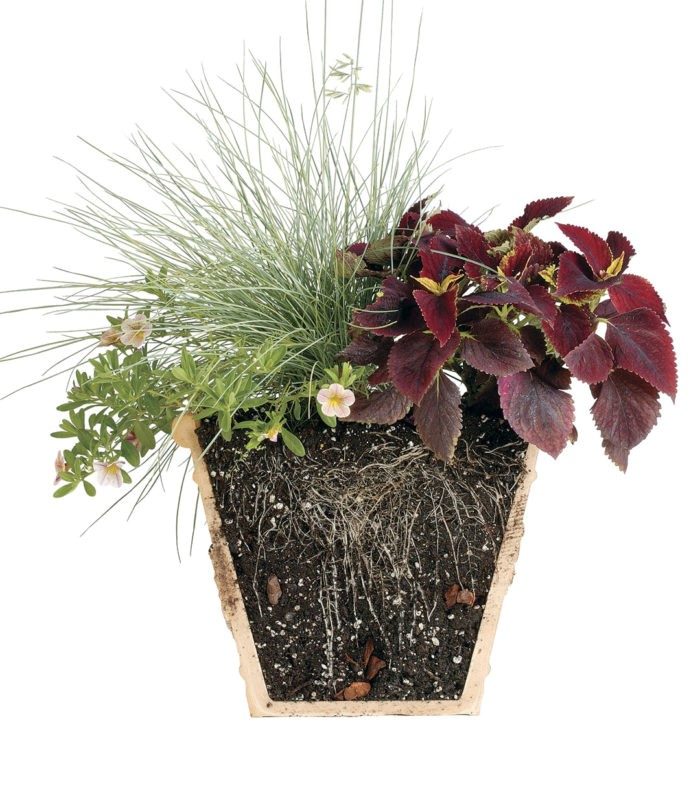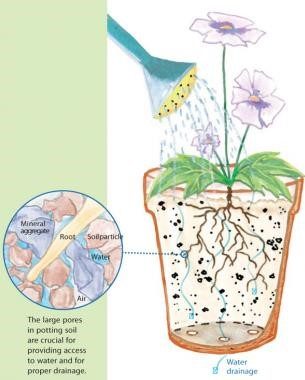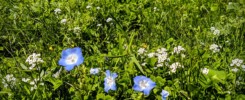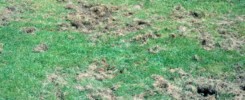Submitted By: Egan Davis, Tara Moreau and Douglas Justice, UBC Botanical Garden
Learning to grow food is a great way to connect to nature and to agriculture, all while spending time outdoors. With over 42 Grow Green food-plant garden designs there are plenty of options to choose from, whether you’re a beginner or an experienced green thumb. Below are some important factors to consider when growing food in containers.
Growing Food in Small Spaces: Container Considerations
Food gardens come in many sizes. With only a few exceptions, most food plants can be grown in containers.
It is important to understand that growing plants in containers is fundamentally different than growing plants in terrestrial soil. For example, the walls and bottoms of containers are sealed and this affects the movement of water, air and roots, and generally requires that potting mixes have a higher air-filled porosity (i.e., more air space wiyhin the soil) in order to supply adequate oxygen to the roots. Potting mixes are also less chemically and biologically stable than natural soil, so plants are more prone to health issues associated with nutrition and disease. So, yes, most plants can be grown in containers if you understand the principles and know a few tricks.
Permanent Plantings vs. Annual Plantings
When considering food crops, we think of fruits, vegetables and herbs. Tree and bush fruits and a number of herbs have permanent above-ground stems and roots, while most vegetable crops (and a few herbs) are annuals (or biennials, grown as annuals). These have no permanent woody tissues, either above or below ground. The summer growing season may be the same for both woody and non-woody plants—or at least the need for water is similar at that time—but only the woody plants have to endure winter conditions. The presence or absence of woody tissue is an important consideration when it comes to potting mixes.
Porosity and the Behaviour of Water
Potting mixes to be used in summer are designed with lower porosity to retain more water. To prevent plants from rotting, high porosity potting mixes that retain less water are used in the winter when it is cold and wet. Generally speaking, larger containers require more porous potting mixes, and smaller containers that dry out faster require less porous and finer-textured potting mixes.
Potting mixes tend to break down over time and after two or three growing seasons, and the porosity in a container can be reduced significantly. For this reason, it is important to freshen up or replace a potting mix as needed.
Potting Mixes Made with Real Soil
It is possible to have success using potting mixes that contain terrestrial soils and composts. In fact, there are some major benefits as natural soils tend to be more chemically and biologically stable. The key here is to ensure sufficient porosity. There is no ideal mixture—every natural soil has different characteristics, and the addition of amendments, such as peat, coir (coconut fibre), composted wood waste, leaf mould or commercial container media, all affect the porosity of the finished potting mix. How much soil to use for your containers will only become apparent with experience. In general, the more soil that is used, the slower that water will move through the mix. As noted, this can be a problem in winter, but is often a significant benefit for summer-producing annual food crops.
Drainage
It is a popular myth that putting gravel, broken terra cotta or another coarse material at the bottom of a container improves drainage. This practice reduces the volume of soil for roots and water storage, and it creates an elevated saturated zone in the potting soil that will, in fact, impede drainage. The best way to ensure good drainage is to use a homogeneous and porous potting mix right to the bottom of the container.
Unless a plant container is elevated slightly off of the ground, water and potting soil can accumulate like a plug between the ground and the pot. Because of this, containers sitting directly on a hard surface will frequently fill with water and saturate during rainy periods. To prevent this phenomenon, shim containers in three locations along the circumference with materials that are at least 8 – 10 mm thick. Strips of wooden lath or small ceramic tiles work well for this. Some containers come with special “feet” designed for this purpose.
Irrigation Techniques
Potting mix needs to dry down significantly between watering cycles. When a containerized plant is thoroughly watered, the container essentially fills up with water like a bucket and the mix is momentarily saturated. After the gravitational water drains, the potting mix remains wet. If the plant is watered again too soon, plant root function is negatively impacted due to a lack of oxygen and the proliferation of pathogenic diseases that thrive in poorly drained conditions. It is, however, important to saturate the potting mix on each watering cycle so that the salts present in fertilizers do not accumulate and burn the plant. A common mistake gardeners make when watering plants is to provide frequent, light applications of water that do not sufficiently flush the salts out of the potting soil. The resulting accumulated salts can cause leaf tips and margins to burn.
The best practice is to allow the potting soil to dry down between water applications and then to irrigate thoroughly so that there is significant water draining from the bottom of the container. Be careful though, because plants in containers have a narrow threshold for tolerating dryness. In terrestrial soils, plants will tend to have more extensive root systems that are able to extract small amounts of available water. In potting mix in a container, plants can tolerate dryness to a point, but will quickly collapse and die once that threshold is reached.
Knowing how and when to water plants is an important skill that takes experience to master. The type of plant, stage of growth, time of year, time of day, weather, type of container and type of potting mix are all important considerations that inform watering decisions.


Nutrition
Food plants need nutrition to grow well. Most potting mixes are developed with materials that have little to no nutritional value. Because of this, it is essential to provide supplementary nutrition with the use of fertilizers. Gardeners have a choice to use natural or synthetic fertilizers.
Natural fertilizers are derived from plant and animal sources, or they are derived from minerals, but not processed chemically in the same way as synthetics fertilizers. Natural fertilizers tend to release nutrients at a slower rate than synthetics and are typically incorporated into the potting mix before planting. Some natural fertilizers, such as alfalfa pellets and worm composts can be applied mid season (as a “side-dressing”) to the growing crop.
When considering synthetic fertilizers, it is best to select a complete and balanced fertilizer that contains both macro-nutrients and micro-nutrients. Carefully follow the bag rates and err on the side of using less rather than more, as the suggested rates of use on the labels of retail grade synthetic fertilizer products tend to be higher than what is actually needed, and can result in rapid, but poor growth quality and an increase in pest and disease susceptibility. And note that the use of synthetic fertilizers often has polluting effects on the environment, as the materials when over-used are easily carried away in irrigation or ground water.
Nutrient Availability and pH
Unlike terrestrial garden soils (which generally maintain a more stable pH), potting soils tend to become excessively acidic relatively quickly, as nutrients are carried away with irrigation water. Even after one or two gardening seasons, the soil pH can become acidic enough to compromise nutrient uptake and plant health. Repotting plants will usually restore the proper pH. Alternatively, every year or so containerized plantings can receive a light dusting of dolomite lime, which is then scratched into the soil.
Healthy Soil Ecology
Many pathogenic root diseases in terrestrial soil are kept at bay because of the complex interactions between roots and microorganisms occurring within the root zone of plants. A rich microflora in soil contributes to chemical defense responses to pathogens, microbial competition and predation, and general ecological stability. In sterilized potting soils, these complex systems do not exist; when a pathogenic organism is present, soil- and water-borne diseases can easily develop in the plants roots. The conditions favouring disease are often created when potting soils are kept too moist.
Even though terrestrial soils can be quite healthy, the healthy balance will destabilize when conditions change. Dormant pathogens and spores are ubiquitous in soils and can persist for years, waiting for favourable conditions and an appropriate host plant. This is one reason why it is challenging to use terrestrial soils in potting mixes. In situ, a soil can be healthy and stable, but in a containerized environment, the conditions are often conducive to disease proliferation. When watered, plant containers will fill up with water like a bucket and soil will be periodically saturated and nearly devoid of oxygen. Those conditions, combined with the fact that soil in containers is often warmer, means that the conditions for disease are ideal. For this reason, professional growers will often heat-sterilize terrestrial soil before adding it in a potting mix.
Types of Containers
The size, shape and materials of a plant container all have an effect on growing plants. Containers need to be a suitable size for the plants being grown. When initially potting, it is advisable to allow room for root growth. Often, containers are planted quite heavily in order to achieve a full look sooner. In this case, containers become root-bound quickly and watering will be necessary more often. It is remarkable how quickly plants grow, so start off with fewer plants and patiently let them grow in to their pots. This will save time and water later in the summer.
Any container used for growing plants must have drainage holes in the bottom. Even still, the bottoms of containers are still mostly an impermeable material so even though water drains through the hole, the potting mix at the bottom of the container will be saturated after watering. When growing in shallow pots, this saturated layer will occupy more of the root zone than in deeper pots. Knowing this, it is advisable to use deeper containers for plants that require good drainage. This allows plants that do not like to “get their feet wet” to stay up and above the bottom of the pot where potting mixes tend to get a little soggy.
Plastic pots are inexpensive and light-weight and come in many colours and finishes. They will last for many years but will fade in the sun and ultimately become quite brittle from UV damage. Terra cotta pots are porous and will draw water from the potting mix and require watering more often. Fertilizer salts can also migrate through the terra cotta walls leaving white efflorescence staining on the outside of the pot. Glazed ceramic pots are heavy, but much like plastic pots in their ability to hold water, and are more resilient than unglazed terra cotta.
A reservoir tray is always a good idea. It will prevent tannins in the potting soil from staining hard surfaces. It is best to make sure that containers are sitting on shims that elevate the bottom of the pot from the surface of the tray. If this isn’t done, the drainage hole can effectively plug and limit the drainage. It is also not good to have the bottom of the pot sitting in water. This can lead to a root rot disease if the mix stays wet for too long.
Conclusion
Growing food plants in containers is fundamentally different than growing plants in the ground in almost every way. It requires us to understand and consider multiple variables – container size and shape, mix porosity, water, nutrition and disease environment. When everything comes together, all sorts of plants—including food plants—can be grown in containers. There is almost no limitation where containerized plants can be grown so it is something everyone can do. Have fun!




This is the best article I have ever seen on the challenges that come with growing plants in containers. Thanks to UBC Botanical Garden staff for sharing their technical expertise.
This was a lot of information and would interest an avid or somewhat experienced gardener like myself. For someone new to gardening in containers it would be great to have some simple examples that are quick and easy for anyone to grow. Novice gardeners need to have some success to continue their efforts. Perhaps a lettuce container, size, type of soil to buy, type of lettuce and throw in a few compatible and edible flowers to make the container interesting and pretty to look at. I would love to see some examples like this.